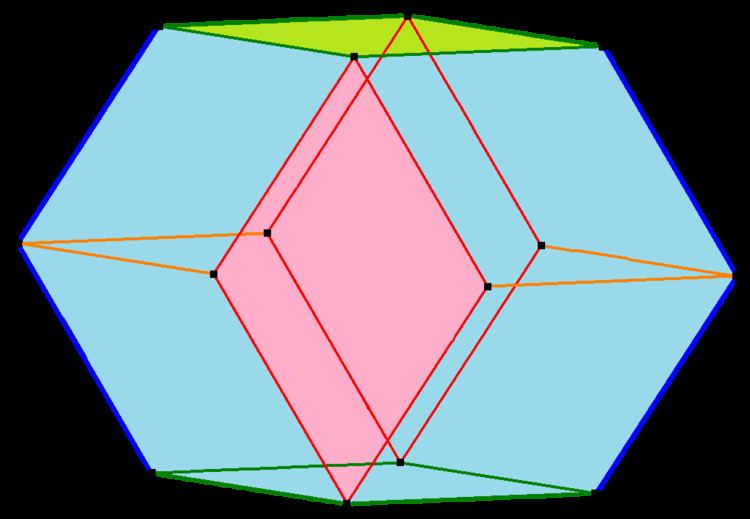 | ||
In geometry, the Bilinski dodecahedron is a 12-sided convex polyhedron with congruent rhombic faces. It has the same topology but different geometry from the face transitive rhombic dodecahedron, another 12-sided polyhedron with congruent rhombic faces.
Contents
History
This shape appears in a 1752 book by John Lodge Cowley, labeled as the dodecarhombus. It is named after Stanko Bilinski, who rediscovered it in 1960. Bilinski himself called it the rhombic dodecahedron of the second kind. Bilinski's discovery corrected a 75-year-old omission in Evgraf Fedorov's classification of convex polyhedra with congruent rhombic faces.
Properties
In the rhombi of the Bilinski dodecahedron, the ratio of lengths of the two diagonals is the golden ratio; that is, the faces of this shape are golden rhombi. In contrast, for the standard rhombic dodecahedron the corresponding ratio is the square root of 2.
This shape is a zonohedron. Like the rhombic dodecahedron, it can tile three-dimensional space by translation, making it a parallelohedron.
Relation to rhombic dodecahedron
The Bilinski dodecahedron and rhombic dodecahedron have the same topology: their vertices, edges, and faces correspond one-for-one, in an adjacency-preserving way. However, their geometry is different. In a 1962 paper, H. S. M. Coxeter claimed that the Bilinski dodecahedron could be obtained by an affine transformation from the rhombic dodecahedron, but this is false. For, in the Bilinski dodecahedron, the long body diagonal is parallel to the short diagonals of two faces, and to the long diagonals of two other faces. In the rhombic dodecahedron, the corresponding body diagonal is parallel to four short face diagonals, and in any affine transformation of the rhombic dodecahedron this body diagonal would remain parallel to four equal-length face diagonals. Another difference between the two dodecahedra is that, in the rhombic dodecahedron, all the body diagonals connecting opposite degree-4 vertices are parallel to face diagonals, while in the Bilinski dodecahedron the shorter body diagonals of this type have no parallel face diagonals.
Related zonohedra
The Bilinski dodecahedron can be formed from the rhombic triacontahedron (another zonohedron with 30 golden rhombic faces) by removing or collapsing two zones or belts of faces with parallel edges. Removing only one of these two zones produces, instead, the rhombic icosahedron, and removing three produces the golden rhombohedra. The Bilinski dodecahedron can be dissected into four golden rhombohedra, two of each type.
The vertices of these zonohedra can be computed by linear combinations of 3 to 6 vectors. A belt mn means n directional vectors, each containing m coparallel congruent edges. The Bilinski dodecahedron has 4 belts of 6 coparallel edges.
